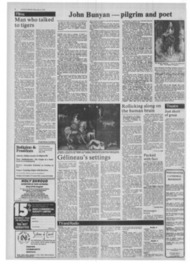Page 2, 14th July 1978
Page 2

Report an error
Noticed an error on this page?If you've noticed an error in this article please click here to report it.
Tags
Share
Related articles
Cardinal Daly Prays: 'attempt The Impossible'
Episcopal
Ecumenical And Historic Milestone Passed
First New Shared Church To Be Built In Liverpool
I Three Defiant Dutch Priests Suspended
Outburst at Commons Mass
By David Browne
The Rev Jan Paisley and the Rev Robert Bradford made a Spectacle of themselves by their protest at the start of the special commemorative Mass in the House of Commons, last week — the first Mass in the Crypt Chapel since the Reformation.
That was the reaction of some of the other Members of Parliament who were in the congregation.
But Cardinal Hume, the celebrant, was not greatly troubled by the protest. He said afterwards: "In the rough and tumble of public life, that is the kind of thing that happens ... it showed how much we need to pray for unity."
Cardinal Hume came out to the altar at exactly the moment Big Ben struck noon. As the congregation of 200 stood up, Mr Paisley stepped into the aisle, waited until the Cardinal had removed his mitre and then delivered a prepared protest. "Before this service proceeds, I want to make a solemn protest in the name of Jesus Christ, the Great King and Head of the Church," he said. "You cannot reverse 400 years of history in this service today."
He went on to describe the Mass as "a blasphemous fable and a dangerous deceit" — a reference to the Church of England's 39 Articles.
While the protest was being delivered, Cardinal Hume stood at the lectern. There were cries of "Rubbish" and "Get out of here" from among the congregation — very much in the manner of a reaction in the Chamber of the House of Commons.
Mr Paisley and Mr Bradford were escorted from the chapel by plain-clothes police.
Cardinal Flume had been invited to celebrate Mass in St Stephen's Crypt, the small chapel in the Houses of Parliament, to commemorate the birth 500 years ago of St Thomas More and his execution on July 6, 1535.
The idea of marking the anniversaries with a Mass in the Palace of Westminster was that of the Catholic MP Mr Kevin McNamara, and it received the enthusiastic support of the Speaker and the Lord Chancellor.
It is understood that the CORsent of the Archbishop of Canterbury and the Queen were also required and granted.
The Lessons were read by the two successors in office of Thomas More — the Lord Chancellor, Lord Elwyn-Jones, and the Speaker of the House of Commons, Mr George Thomas.
Mr James Hamilton, MP, Vice Chancellor of the Household, served the Mass, and Canon Baker, Chaplain to the Speaker, read the Psalm between the Lessons. Catholic MPs among the congregation included Mr Gerry Fitt (SDLP, Belfast West).
During his sermon, Cardinal Hume explained that he WRS using a silver chalice which was made in 1529 — the year of the Reformation Parliament.
"This chalice is not only a precious link with the past," he said. "I pray that the use to which it is put will prove to he an instrument for the healing of ancient wounds."
He told the congregation: "We are looking back to July 6, 1535, when More was beheaded, but this we do only to look forward boldly and confidently to a future for our countrymen when the values of the spirit and the teaching of Christ provide criteria for the guidance of all in a complex and complicated society.
"Thomas More was made of the stuff of which martyrs are made, but only because he was already a saint. Wholeness and integrity were already his. It enabled him to see clearly — to discern and judge.
"He was his own man, free in person and clear In his mind. He had lived according to the dictates of his conscience, and a man who thus lives has relatively little problem In dying."
It is thought that the same Crypt Chapel was used by St Thomas More, although the chapel itself has had a chequered history since his time.
Cromwell used it as stables; it has been ravaged by fire at least five times, and was used as a storeroom before being restored as a chapel in 1834. It is elaborately decorated in gold and red ornate Victorian paintwork.
blog comments powered by Disqus











